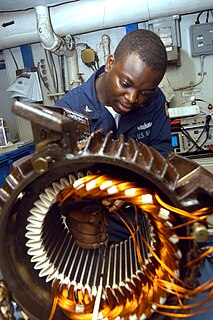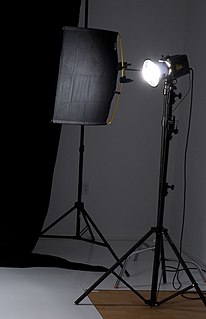
In film and television crews, the gaffer or chief lighting technician is the head electrician, responsible for the execution (and sometimes the design) of the lighting plan for a production. The gaffer's assistant is the best boy electric.

In film and television crews, the gaffer or chief lighting technician is the head electrician, responsible for the execution (and sometimes the design) of the lighting plan for a production. The gaffer's assistant is the best boy electric.
There are several possible explanations for the history of the term Gaffer.
One possibility is that the term originally referred to the moving of overhead equipment to control lighting levels using a gaff. [1]
Another potential origin is as a contraction of "godfather", originally applied by country people to an elderly man, or one whose position entitled him to respect; the female equivalent was "gammer", a contraction of "godmother". [2] Both words are found in the comic play Gammer Gurton's Needle , printed in 1575 but possibly written earlier.
In this etymology, "gaffer" later became used more generally for a "master" or "governor", and by 1841 was applied to foremen and supervisors of gangs of workmen.
In any case, it has been applied specifically to the chief electrician on a film set since the 1920s. [2] The Oxford English Dictionary includes a citation from Picture-Play Magazine of 1926 [2] and a 1929 book on motion picture production also uses the term. [3]
The gaffer is responsible for managing lighting, including associated resources such as labour, lighting instruments and electrical equipment under the direction of the director of photography (DP, DOP or Cinematographer) or, in television, the lighting director (LD).
The DP/LD is responsible for the overall lighting design, but delegates the implementation of the design to the gaffer and the key grip. The key grip is the head grip, in charge of the labour and non-electrical equipment used to support and modify the lighting. Grip equipment includes stands, flags and gobos. The gaffer will usually have an assistant called a best boy and, depending on the size of the job, crew members who are called "set lighting technicians" or "electricians", although not all of them are trained as electricians in the usual sense of the term.
The name of the position gives its name by association to gaffer tape, a strong cloth-backed adhesive tape used within the film and TV industry. Gaffer tape is typically utilized by set lighting technicians under the supervision of, and not directly by, a gaffer. Many other types of tape are also used in the industry, such as paper tape, pressure-sensitive tape (A.K.A. snot tape), electrical tape, J-LAR, and cloth tape.

A film crew is a group of people, hired by a production company, for the purpose of producing a film or motion picture. The crew is distinguished from the cast, as the cast are understood to be the actors who appear in front of the camera or provide voices for characters in the film. The crew is also separate from the producers, as the producers are the ones who own a portion of either the film studio or the film's intellectual property rights. A film crew is divided into different departments, each of which specializes in a specific aspect of the production. Film crew positions have evolved over the years, spurred by technological change, but many traditional jobs date from the early 20th century and are common across jurisdictions and filmmaking cultures.

Gaffer tape is a heavy cotton cloth pressure-sensitive tape with strong adhesive and tensile properties. It is widely used in theatre, photography, film, radio and television production, and industrial staging work.

An electrician is a tradesman specializing in electrical wiring of buildings, transmission lines, stationary machines, and related equipment. Electricians may be employed in the installation of new electrical components or the maintenance and repair of existing electrical infrastructure. Electricians may also specialize in wiring ships, airplanes, and other mobile platforms, as well as data and cable lines.
Electrical lighting technicians (ELT), or simply lighting tech, are involved with rigging stage and location sets and controlling artificial, electric lights for art and entertainment venues or in video, television, or film production.
"Below-the-line" is a term derived from the top sheet of a film budget for motion pictures, television programs, industrial films, independent films, student films and documentaries as well as commercials. The "line" in "below-the-line" refers to the separation of production costs between script and story writers, producers, directors, actors, and casting and the rest of the crew, or production team.

In North American filmmaking a key grip is a senior role for an experienced professional necessary on every set. Their responsibilities are extensive and range from supervising grip crews, assessing what equipment is necessary for each shooting location, coordinating the transportation of this equipment and its set up, arranging the general movement and positioning of the camera and collaborating with the director of photography. The key grip relies on the best boy as their second in command to aid in coordinating the grip crew.

In the United States, Canada and the United Kingdom, grips are technicians in the filmmaking and video production industries. They constitute their own department on a film set and are directed by a key grip. Grips have two main functions. The first is to work closely with the camera department to provide camera support, especially if the camera is mounted to a dolly, crane, or in an unusual position, such as the top of a ladder. Some grips may specialize in operating camera dollies or camera cranes. The second main function of grips is to work closely with the electrical department to create lighting set-ups necessary for a shot under the direction of the director of photography.
Grips' responsibility is to build and maintain all the equipment that supports cameras. This equipment, which includes tripods, dollies, tracks, jibs, cranes, and static rigs, is constructed of delicate yet heavy duty parts requiring a high level of experience to operate and move. Every scene in a feature film is shot using one or more cameras, each mounted on highly complex, extremely expensive, heavy duty equipment. Grips assemble this equipment according to meticulous specifications and push, pull, mount or hang it from a variety of settings. The equipment can be as basic as a tripod standing on a studio floor, to hazardous operations such as mounting a camera on a 100 ft crane, or hanging it from a helicopter swooping above a mountain range.
Good Grips perform a crucial role in ensuring that the artifice of film is maintained, and that camera moves are as seamless as possible. Grips are usually requested by the DoP or the camera operator. Although the work is physically demanding and the hours are long, the work can be very rewarding. Many Grips work on both commercials and features.
In a film crew there are two kinds of best boy: best boy electric and best boy grip. They are assistants to their department heads, the gaffer and the key grip, respectively. In short, the best boy acts as the foreman for the department. A female who performs the duties of a best boy may be called best girl.

A sound stage is a soundproof, large structure, building, or room with large doors and high ceilings, used for the production of theatrical film-making and television productions, usually located on a secured movie or television studio property.
Running crew, run crew or stage crew, is a collective term used in theatre to describe the members of the technical crew who supervise and operate ("run") the various technical aspects of the production during a performance. While the "technical crew" includes all persons other than performers involved with the production, such as those who build and take down the sets and place the lighting, the term "running crew" is generally limited to those who work during an actual performance.

A supervisor, or lead, is the job title of a lower-level management position that is primarily based on authority over workers or workplace. A supervisor can also be one of the most senior in the staff at the place of work, such as a professor who oversees a PhD dissertation. Supervision, on the other hand, can be performed by people without this formal title, for example by parents. The term supervisor itself can be used to refer to any personnel who have this task as part of their job description.
In theatre, the master electrician is responsible for implementing the lighting design for a production drawn up by the lighting designer. This involves overseeing the preparation, hanging, connection and focusing of stage lighting fixtures.
Television crew positions are derived from those of film crew, but with several differences.

In film production, a C-stand is primarily used to position light modifiers, such as silks, nets, or flags, in front of light sources. The stand is constructed of metal and consists of a collapsible base, two riser columns, and a baby pin on top. In addition, a C-stand typically includes a gobo head and a gobo arm, also known as a grip head and grip arm, which provide the ability to articulate a light modifier without moving the stand itself. The legs of C stands are designed to be nested, so many stands can be placed around a light source.
A stagehand is a person who works backstage or behind the scenes in theatres, film, television, or location performance. Their work include setting up the scenery, lights, sound, props, rigging, and special effects for a production.
A theatrical technician, is a person who operates technical equipment and systems in the performing arts and entertainment industry. In contrast to performers, this broad category contains all "unseen" theatrical personnel who practice stagecraft and are responsible for the logistic and production-related aspects of a performance including designers, operators, and supervisors.

In theatre, an electrician is a person who works with the various aspects of lighting. Some of the positions among electricians include the lighting supervisor, master electrician, deck electrician, light board operator, moving light programmer, followspot operator, as well as simply electricians. This group is generally known as the "Electrics" Department or LX Department.

A flag is a device used in lighting for motion picture and still photography to block light. It can be used to cast a shadow, provide negative fill, or protect the lens from a flare. Its usage is generally dictated by the director of photography, but the responsibility for placing them can vary by region, usually devolving to either the gaffer and electricians or the key grip and lighting grips.
Articles related to the field of motion pictures include:

Pressure-sensitive tape, known also in various countries as PSA tape, adhesive tape, self-stick tape, sticky tape, Sellotape, or just tape, is an adhesive tape that will stick with application of pressure, without the need for a solvent or heat for activation. It can be used in the home, office, industry, and institutions for a wide variety of purposes.